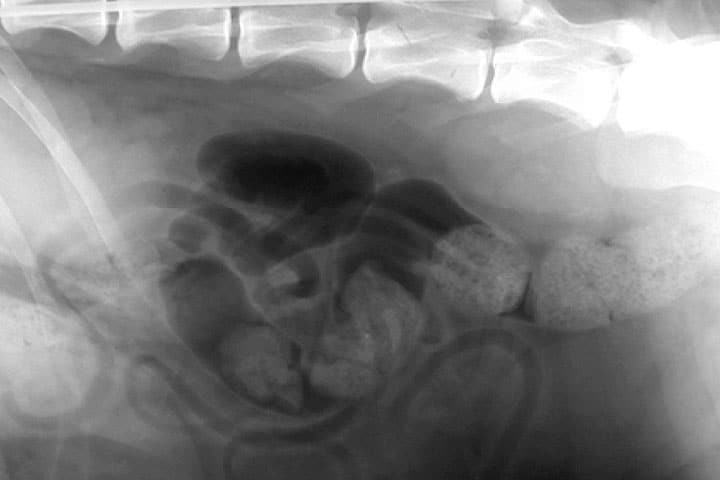
Indications for biopsy
Full thickness intestinal biopsies may be taken to investigate gastrointestinal signs. Dehiscence of the sutures can lead to the life-threatening complication of septic peritonitis and so these risks need to be relayed to the owners.
Biopsy technique
Full thickness biopsies are recommended. Biopsies are performed either using a skin biopsy punch (6 or 8mm) or using a scalpel blade and Metzenbaum scissors.
Take the biopsy on the antimesenteric border of the intestine, or over the lesion, if present.
If operating on the ilium, to avoid the antimesenteric blood vessel, take your biopsy adjacent to this vessel to avoid haemorrhage. The incision can be extended using Metzenbaum scissors. It is useful when the lumen of the GI tract is entered to keep all contaminated instruments separate from instruments that will be used for closure, or use a separate kit to close.
The intestinal loop is elevated from the abdomen, which is packed off using moistened laparotomy swabs.
To use a skin biopsy punch, the intestine is held by an assistant or using Doyen forceps on the first click of the ratchet only to occlude the lumen. The punch is passed full thickness through the antimesenteric surface of the intestine, with care not to penetrate the far wall of the intestine. The sample is retrieved using Debakey forceps and the defect is closed.
If a skin biopsy punch is not available, an incision can be made in the antimesenteric border using a number 11 scalpel blade.
The hole is made larger using Metzenbaum scissors. Care is taken to achieve a sample large enough for diagnostic purposes but not so large that closure is compromised. Rather than closing the intestine longitudinally, parallel to the mesentery, you can close transversely if the diameter of the lumen is compromised.
Use monofilament absorbable suture such as Monocryl or PDS to close the intestine.
Most of the time when you are performing a biopsy, the intestine is abnormal; therefore, use PDS because of its prolonged absorption times. Use fine sutures to avoid making large holes in the intestine; 2 metric PDS for large dogs and 1.5 metric for cats to medium sized dogs. Be very atraumatic when handling intestines with instruments; do not grasp the edges with your forceps if possible; only Debakey forceps should be used. Place your sutures 2-3mm apart and at least 5mm from the edge of your incision. The strength-holding layer is the submucosa so it is important to go full thickness through the intestine. You can either place simple interrupted or simple continuous sutures; We prefer simple interrupted sutures. Sutures should be snug, tighter than skin sutures but not so tight that they strangle the tissue. After you have finished suturing, you can inject saline into the lumen of the intestine using an orange needle (25g) to test for leaks.
Lavage the surgical site/abdomen with warm saline, change gloves and instruments and omentalise the incision.
To do this you can just place the omentum over the sutures to provide extra security against small leaks. If there is no omentum available (it has been removed during a previous surgery or it is diseased) you can perform a serosal patch. This is where a free loop of intestine is sutured over the incision to allow the serosa to provide a source of mesenchymal cells to speed up healing and to provide a seal against leakage. To do this, 2 free loose loops of intestine are sutured together using 1.5 metric Monocryl and then sutured over the enterotomy site, again using Monocryl in a simple interrupted pattern.

Case Advice or Arranging a Referral
If you are a veterinary professional and would like to discuss a case with one of our team, or require pre-referral advice about a patient, please call 01883 741449. Alternatively, to refer a case, please use the online referral form
About The Discipline
Soft Tissue Surgery

Need case advice or have any questions?
If you have any questions or would like advice on a case please call our dedicated vet line on 01883 741449 and ask to speak to one of our Soft Tissue Surgery team.
Advice is freely available, even if the case cannot be referred.
Soft Tissue Surgery Team
Our Soft Tissue Surgery Team offer a caring, multi-disciplinary approach to all medical and surgical conditions.